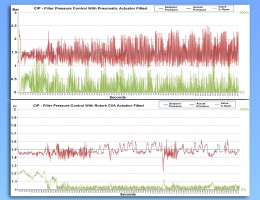Rotork electric valve control
contributes to Coca-Cola Enterprises environmental improvements

A Rotork engineer demonstrates the improved control valve performance illustrated by the Rotork CVA actuator’s datalogger.

These two graphs show the improved positional accuracy of the CVA actuator in comparison with the pneumatic actuator in the production mode.

These two graphs show the improved positional accuracy of the CVA actuator in comparison with the pneumatic actuator in the CIP (Clean in Place) mode.
CCE has invested over £100 million over the last five years at the Wakefield site, which is the largest soft drinks production plant in Europe, as part of a long term programme highlighting its commitment to local manufacturing and the development of new technologies. Since installing and acting on the information produced by an Energy Monitoring system, the company has sofar reduced electricity consumption at Wakefield by 13% since 2009.
An important part of the plan involves saving the ongoing cost of providing and maintaining an instrument air supply for traditional pneumatic control valve actuation. This is being implemented at Wakefield by the introduction of the Rotork CVA control valve actuator to perform modulating and failsafe valve duties.
A recent example is on the production line where the adoption of Rotork CVA technology for a demanding valve duty has considerably reduced the cost of energy consumption when compared with traditional pneumatic actuation with no loss of performance.
Andy Reynolds, Automation Engineer at the Wakefield plant, takes up the story:
‘We were looking for an alternative to pneumatic control valves in order to remove the need for compressed air as much as possible in the area and reduce costs. Based on average air usage of 2m3/hr for a 3˝ control valve at £0.05 per m3, the running cost would be £870 per annum. The CVA actuator, using an average of 10 Watts at £0.15/kW, would cost £13 for the same period. This represents a minimum saving of £857 per annum per valve, as this figure does not take into consideration any leaks in the system.
‘Up to now, electrically actuated valves could not respond fast enough to maintain good pressure control in the bottle filling machine. Rotork were confident that their CVA actuator would not only give a similarperformance to our existing valve, but would also be cheaper to run. Their confidence was so high they offered us an actuator on a sale or return basis if it did not meet expectations in any way.
‘To prove this, the performance of the existing pneumatic control valve on the main product feed into the filling machine was first monitored and recorded. Using an adaptor made at Rotork’s facility in Leeds, the CVA actuator was then fitted to the same valve and connected to the existing 4-20mA control signal from the PLC.
‘After running and monitoring the CVA actuator in a 24-7 operation for 1 month, the results from the two actuators were compared. The graphs clearly show that in production mode the CVA performs equally well, if not better than the pneumatic actuator. However, when in CIP (Clean in Place) cleaning mode, the performance of the CVA is much better than the pneumatic. This is because the CVA actuator does not overshoot the set point like the pneumatic actuator does when the set point is lower and back pressure in the circuit is higher when in CIP mode.’
Commenting on the work at Wakefield, Rotork UK Site Services Manager Ian Elliott said: ‘We were asked by CCE to improve the production operation, which has been successfully achieved with the added benefit of a reduced reliance on costly instrument air. We are looking forward to the future with this householdname company and the opportunity to introduce our innovative products throughout their global operations.’
Rotork UK
Tel: +44 1225 733200
www.rotork.com

| Telephone: | 0113 256 7922 |
| Email: | mail@rotork.com |
| Website: | www.rotork.com |
| More information on the Rotork UK BVAA Member Directory Page |
Search related valve / actuator articles: Rotork UKIssue 30ActuatorsElectric Actuators













